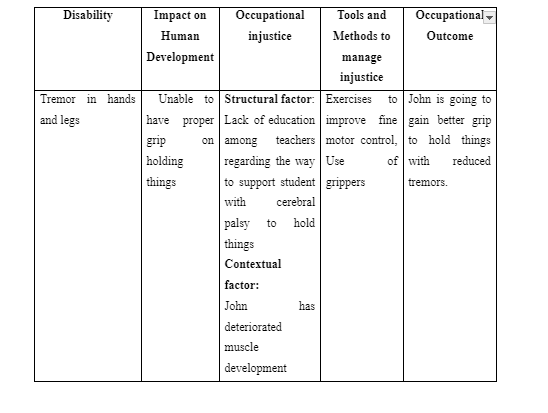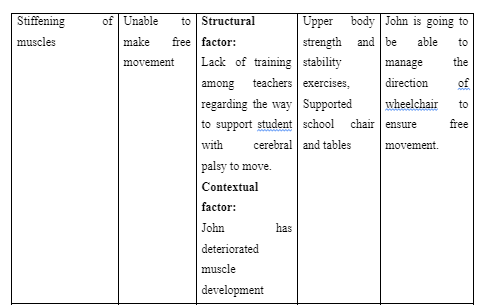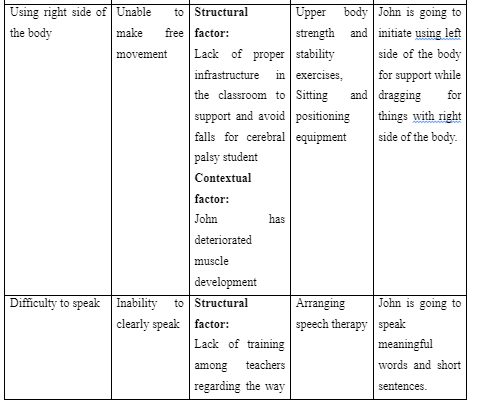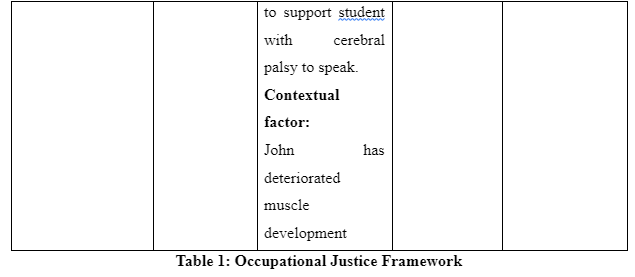Critical Analysis of The Reporting
HUMAN OCCUPATION AND LIFESPAN
The occupational therapist is an individual who is involved in the treatment of disabled patients by using therapeutic services and devices to help the patients develop, improve and recover as well as have skills needed by them to execute their daily activities. In this assignment, an occupational-focused intervention plan is to be developed for an individual named John suffering from cerebral palsy so that he can execute his activities effectively with less assistance. The intervention mentioned in the plan for John is to be justified regarding the way it is going to help him fulfil his occupational activities, which aligns with the principles of healthcare dissertation help for those studying similar cases.
The occupation is referred to the way a person is spending their time and student is considered as an occupation because it a productive way in which individual spends their time trying to learn new things to live life (Wells and Lynch, 2012). In this case study, John is a 10-year-old boy who is suffering from cerebral palsy and his present occupation is student where he is trying to learn and get educated about basic activities including drawing, writing, reading and others. As asserted by Towns et al. (2018), cerebral palsy is a nature neurological disease in which the person has impaired muscle coordination along with other disabilities and has a damaged brain before birth. The individuals with cerebral palsy experience hindrance with movement, cognitive ability, social activities, thinking and reasoning and others. The stiffening of muscles among individuals with cerebral palsy is seen because in them the cerebral cortex region of the brain that control muscle movement has lost their ability to properly maintain and send signals through the neurons to direct effective muscle movement (Bonnechere et al. 2017). In case of John, the individual experience hindrance to move due to stiffening of muscles and exaggerated reflexes in hands and legs. This is leading John to face occupational risk of falls from his wheelchair while trying to move from one place to another within the classroom. It is evident as one day while moving from one classroom to another he fell from his wheelchair that was driven by him without help and it leads him to experience a deep cut on his forehead.
The individuals with cerebral palsy are seen to experience tremors in hands and legs due to which they fail to properly grip or hold things as well as stand (Appleton and Gupta, 2019). In case of John, it is seen that he also faces tremor in hands and legs which is leading him to face occupational risk of failing to stand and hold things to writer, play, draw or execute other activities. In one instance, while drinking water from glass due to tremor in the hand John failed to hold the glass and it dropped to pieces as well as it leads few glass pieces to hurt his leg leading him to experience wound on the leg. In addition, due to tremor in the hand, John is unable to have the knowledge to write and draw properly as he cannot hold pen or crayons properly. John is seen to favour moving right side of the body to reach or drag things without trying to use his left side to hold for protection from falling. This has led him to face occupation risk of experiencing uncertain falls in the classroom setting. It is evident as while trying to drag a colour palate from the self to paint he fell from his wheelchair due to lack of using his left side of the body to hold on the rack.

The Occupational Justice Framework informs about the way inter-relationship of contextual and structural factors restrict or support occupational rights and outcomes. The structural factors are economy, national policies, education etc while the contextual factors are age, disability, sexual orientation, etc. The occupational outcomes of justice are occupational rights (Whiteford et al. 2018).




The occupation-centred approach ensures that the process of therapy provided to the patient is rooted in the occupation and includes meaningful intervention as well as effectively examines the environment of the client to determine in which context the individual requires the assistance of therapy to live a better life (Rodger and Kennedy-Behr, 2017). The occupational-centred practice is related to John in this case when the occupational therapist was reviewing his environment within the classroom to understand the nature of exercises and tools to be used to make John more efficient to control his movement and activities in the occupation of being a student. The occupational-focused intervention is related to concentrating on a particular occupation to help individuals with disability in the occupation execute their daily activities with less hindrance and assistance (Margot-Cattin et al. 2018). The occupation-focused intervention for John would be when the occupational therapist is focussed on determining specific ranges of exercises and tools to be used such as fine motor control exercises, upper body strength exercises and others for supporting individuals like John who are specifically related to student occupation. Occupation-based intervention is referred to the one in which the patient is actively completing an occupation as the primary part of the intervention process related to occupational therapy (Daud et al. 2016). The occupation-based intervention is executed for John when the occupational therapist has completed the therapy which is arching of hands, finger isolation, in-hand manipulation and others for the individual while playing with toys and pushing coin in the piggy bank with him in the classroom.
The occupational therapist to improve hand movement and making the children with cerebral palsy manage tremors in hands uses hand therapy exercises to improve fine motor skills of the individual. This is because in this exercise squeezing and holding the ball in different angles within the hand improves finger coordination as well as strengthens the hand to make free movement effectively (Peters et al. 2019). Thus, in the case of John, the occupational therapist to improve his finger coordination and the handgrip is required to use hand therapy ball exercises. This is because squeezing the ball with thumbs and fingers on the pads and tips of the finger would help John to gain strength in his fingers irrespective of tremors to fold properly and grip on things more firmly. The exercise is going to address John’s occupational risk of failing to hold or grip things such as glass, pen, pencil and others for executing activities. Therefore, the intended outcome with the therapy for John would be that he will be able to effectively grip pen or crayons allowing him to be able to write and draw as well as will be self-sufficient to eat by holding spoon and drink by holding glass.
The occupational therapist to improve upper body movements of cerebral palsy children uses playful exercises such as throwing balls in the net, catching things by moving upper part of the body, pouring water and others (Hung et al. 2018). These exercises are efficient to improve upper body movements as while catching and throwing things the individual uses their shoulders, hands and wrist muscles to execute the activity. Thus, the occupational therapist for John to improve his upper body movement is required to involve him into catching and playing with things while sitting so that he can overcome the stiffness in the shoulder and hand muscles in the upper part of the body that is bothering him to run the wheelchair on his own. Therefore, the therapy will address upper body movement issues of John making him able to turn the wheel with his own hands to move freely. The outcome will result John to avoid falling from the wheelchair due to unmanaged wheel coordination that was previously encountered by him while moving from one classroom to another. In order to improve bilateral coordination among cerebral palsy individuals, the occupational therapist uses playful exercises such as drumming, pulling apart things, pushing a rolling pin and others (Liu et al. 2017). This is because in these exercises both the hands are used in executing the task making the individual with cerebral palsy forced to use both hands and side of the body rather than focussing on using single side of the body. The therapist for John is required to use these exercises to help him develop effective coordination and strength of both sides of the body muscles. This will help John to use one hand for support and another hand for grabbing things such as books, colours, toys and others from table or rack without
falling from chair. The intended outcome will be that John will be able to coordinate both sides of the body rather than focussing on using right side of the body for executing daily activities such as using both hands to stand and walk short distances in the classroom without wheelchair to grab things, manage both the wheels of the wheelchair effectively for moving, use both hand to hold books for reading and others. The occupational therapist to improve bilateral coordination uses Paediatric Constraint Induced Movements Therapy (CMIT) in which the weaker part of the body is made to move for executing exercises by avoiding stronger part of the body to be used for short time-period (Peters et al. 2019; Milton et al. 2019). This is efficient to improve body coordination as the service users are focussed to use the weaker body side or parts which improve muscle movement through facilitation which was previously ignored as the person was focused on using the stronger side of the body. The therapy is able to address John’s issue of being focused to use only right side of the body to execute activities in the class and while moving. The outcome of the therapy for John will be that he will be able effectively move both sides of the body to execute tasks with better strength and less hindrances which as faced while using single side or parts of the body.
The speech therapy for cerebral palsy individuals helps them to make properly control muscles in the moth to frame clearly words and sentences for communicating as well as improves their eating and chewing ability for food (Bourke-Taylor et al. 2018). Thus, occupational therapist for John is required to use speech therapy so that he can speak words clearly to express and communicate with others. In the occupation of being a student, speech therapy is going to address John's issue of expressing and talking with others in the class to socialise and informing needs. The proposed outcome for John will be that he will be able to communicate with teachers and others for help regarding movement and lessons reducing his chances of being isolated and ignored to meet his needs.
The above discussion informs that John is a 10-year-old individual who is suffering cerebral palsy that has to render him face issues of being a student as he was reported to face hindrance in moving, gripping things to write and draw, grab things, make clear speeches and others. The occupational justice framework informs that structural factors such as lack of proper infrastructure in the school, improper education and training of teachers to manage students like him resulted to him to experience occupational issues of being a student. The contextual factor indicates that John’s health was the key issue to create hindrances in his occupation. The evidence derived from literature informs that occupational therapist for John is required to use exercises and playful activities for improving motor skills and bilateral coordination so that John can hold and grip things properly to write and draw as well as be self-sufficient to move wheels of the wheelchair to move from one place to another.

Dig deeper into Critical Analysis of Nursing Leadership and Management with our selection of articles.
References
- Appleton, R.E. and Gupta, R., 2019. Cerebral palsy: not always what it seems. Archives of disease in childhood, 104(8), pp.809-814.
- Bonnechere, B., Omelina, L., Jansen, B. and Van Sint Jan, S., 2017. Balance improvement after physical therapy training using specially developed serious games for cerebral palsy children: preliminary results. Disability and rehabilitation, 39(4), pp.403-406.
- Bourke-Taylor, H., Cotter, C., Johnson, L. and Lalor, A., 2018. Belonging, school support and communication: Essential aspects of school success for students with cerebral palsy in mainstream schools. Teaching and Teacher Education, 70, pp.153-164.
- Dancza, K., Missiuna, C. and Pollock, N., 2017. Occupation‐centred Practice: When the Classroom Is Your Client. Occupation-Centred Practice with Children: A Practical Guide for Occupational Therapists, p.257.
- Daud, A.Z.C., Yau, M.K., Barnett, F., Judd, J., Jones, R.E. and Nawawi, R.F.M., 2016. Integration of occupation based intervention in hand injury rehabilitation: a randomized controlled trial. Journal of hand therapy, 29(1), pp.30-40.
- Hung, J.W., Chang, Y.J., Chou, C.X., Wu, W.C., Howell, S. and Lu, W.P., 2018. Developing a Suite of Motion-Controlled Games for Upper Extremity Training in Children with Cerebral Palsy: A Proof-of-Concept Study. Games for health journal, 7(5), pp.327-334.
- Liu, Y.C., Chang, T.W., Liang, K.J., Shieh, J.Y., Chen, H.L. and Wang, T.N., 2017. The effect of the home–based family-friendly bilateral intensive training on motor and psychosocial outcomes in children with hemiplegic cerebral palsy. Journal of the Neurological Sciences, 381, p.927.
- Margot-Cattin, I., Page, J., Petrig, A., Rossini, E., Agustoni, S., Galli-Hudec, C., Roos, K. and Meyer, S., 2018. Creating a continuing professional development course on setting occupation-focused goals. World Federation of Occupational Therapists Bulletin, 74(1), pp.44-51.
- Milton, Y.M., Dunford, C. and Newby, K.V., 2019. Occupational therapy home programmes for children with cerebral palsy: A national survey of United Kingdom paediatric occupational therapy practice. British Journal of Occupational Therapy, p.0308022619830263.
- Peters, C., Chang, A., Morales, A., Barnes, K. and Allegretti, A., 2019. An integrative review of assessments used in occupational therapy interventions for children with cerebral palsy. Cadernos Brasileiros de Terapia Ocupacional, 27(1), pp.168-185.
- Peters, C., Chang, A., Morales, A., Barnes, K. and Allegretti, A., 2019. An integrative review of assessments used in occupational therapy interventions for children with cerebral palsy. Cadernos Brasileiros de Terapia Ocupacional, 27(1), pp.168-185.
- Rodger, S. and Kennedy-Behr, A. eds., 2017. Occupation-centred practice with children: a practical guide for occupational therapists. John Wiley & Sons.
- Towns, M., Rosenbaum, P., Palisano, R. and Wright, F.V., 2018. Should the Gross Motor Function Classification System be used for children who do not have cerebral palsy?. Developmental Medicine & Child Neurology, 60(2), pp.147-154.
- Wells, R.S. and Lynch, C.M., 2012. Delayed college entry and the socioeconomic gap: Examining the roles of student plans, family income, parental education, and parental occupation. The Journal of Higher Education, 83(5), pp.671-697.
- Whiteford, G., Jones, K., Rahal, C. and Suleman, A., 2018. The Participatory Occupational Justice Framework as a tool for change: Three contrasting case narratives. Journal of Occupational Science, 25(4), pp.497-508.
- 24/7 Customer Support
- 100% Customer Satisfaction
- No Privacy Violation
- Quick Services
- Subject Experts



